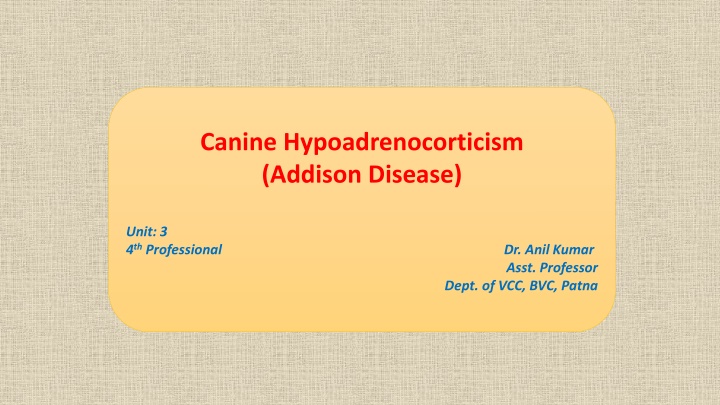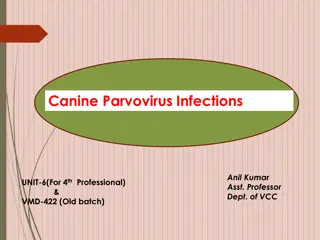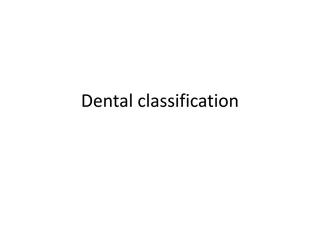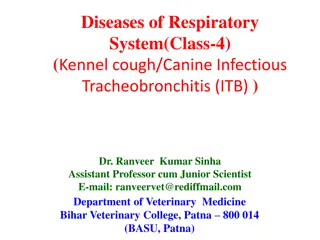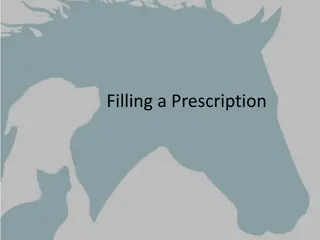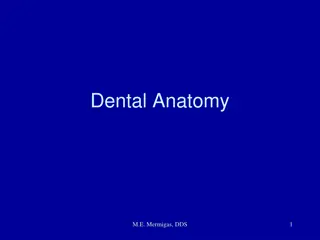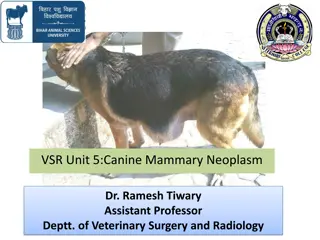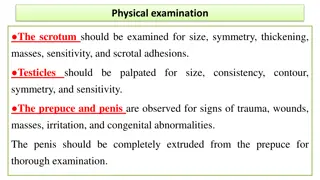Canine Hypoadrenocorticism
Canine hypoadrenocorticism, also known as Addison's Disease, is a condition that affects dogs' adrenal glands, leading to insufficient production of hormones. Learn from Dr. Anil Kumar, Assistant Professor at the Dept. of VCC, BVC, Patna, about the diagnosis, treatment, and management of this disease in dogs.
Download Presentation

Please find below an Image/Link to download the presentation.
The content on the website is provided AS IS for your information and personal use only. It may not be sold, licensed, or shared on other websites without obtaining consent from the author.If you encounter any issues during the download, it is possible that the publisher has removed the file from their server.
You are allowed to download the files provided on this website for personal or commercial use, subject to the condition that they are used lawfully. All files are the property of their respective owners.
The content on the website is provided AS IS for your information and personal use only. It may not be sold, licensed, or shared on other websites without obtaining consent from the author.
E N D
Presentation Transcript
Canine Hypoadrenocorticism (Addison Disease) Unit: 3 4th Professional Dr. Anil Kumar Asst. Professor Dept. of VCC, BVC, Patna
ADDISON DISEASE The adrenal glands are essential for life, being responsible for the minute-to-minute regulation of blood pressure, blood volume, and vascular tone. Outer Zone (Cortex) Inner Zone (Medulla) ADRENAL GLAND Zona fasciculate (70% of the cortex) The zona glomerulosa, Zona reticularis Sex steroids Mineralocorticoid (Aldosterone) Glucocorticoid(Cortisol) carbohydrate, protein, and lipid metabolism result in sparing of glucose Decrease lipogenesis and increase lipolysis in adipose tissue suppress inflammatory and immunologic responses Favors the spread of infection. Negative effect on (fibroblast proliferation synthesis ) Ion transport by epithelial cells, resulting in a loss of potassium and retention of sodium. A lack of mineralocorticoids (Addison disease) may result in a lethal retention of potassium and loss of sodium. Progesterone, and androgens are adrenal sex hormones estrogens, secretion of wound and healing collagen
Adrenal hormones are necessary to control salt, sugar and water balance in the body. It results from the lack of glucocorticoids, mineralocorticoids, or both It is seen most commonly in young to middle-aged female dogs and occasionally in horses. Etiology: Primary Unknown, but most cases probably result from an autoimmune process and characterized by a lack of glucocorticoids and mineralocorticoids. Others : Destruction of the adrenal gland by granulomatous disease Metastatic tumor, Hemorrhage Infarction Adrenolytic agents (mitotane), or adrenal enzyme inhibitors (trilostane)
FORMS OF HYPOADRENOCORTICISM Secondary Primary Atypical Hypoadrenocorticism It is refers to a central (anterior pituitary) deficiency of ACTH and lead to isolated insufficiency Mineralocorticoids are spared because ACTH does not directly influence their release. It mainly results from results from abrupt discontinuation of long-term administration of corticosteroids or progesterone analog Rarely, congenital defects of the pituitary gland ( a cystic Rathke s pouch, neoplasia, or trauma) Hypoadrenocorticism Characterized by a lack of glucocorticoids mineralocorticoids Mostly associated immune-mediated destruction cortical tissue Mitotane or trilostane for Hyperadrenocorticism treatment Neoplasia, infection, infarction of the adrenal glands Hypoadrenocorticism Seen in small population of atypical dogs Adrenal destruction is purported to spare the glomerulosa layer, resulting in an isolated glucocorticoid deficiency and so, do not progress to clinically significant deficiency Isolated glucocorticoid insufficiency is more commonly seen in older dogs with vague GI signs, weight loss, normal electrolyte hypoalbuminemia hypocholesterolemia. and glucocorticoid with of adrenal mineralocorticoid exogenous concentrations, or and
Age, Sex and Breed: Dogs of any sex, age, or breed (including mixed breeds) can develop the disease. The disease is heritable in certain breeds: Clinical Signs: The Addisonian crisis is the life-threatening culmination of combined hormone deficiencies that can be fatal if not appropriately treated
DIAGNOSIS: The disease is diagnosed on the basis of a: Compatible history Clinical signs Laboratory abnormalities Imaging studies and ACTH stimulation test results Note: The combination of Na/K ratio with lymphocyte count is a better screening test for hypoadrenocorticism than either variable alone.
Patients with atypical hypoadrenocorticism are more likely to exhibit hypoalbuminemia, hypocholesterolemia, and anemia on routine blood work. Diagnostic Imaging: Thoracic radiographs may reveal a small heart and caudal vena cava, which indicates hypovolemia On abdominal ultrasonography, atrophy of the adrenal glands with thin and short as compared with normal, but in some cases there may benormal size adrenal glands. ECG: Depending upon the degree of hyperkalemia, the ECG may Reveal a bradyarrhythmia with absent P waves Tented T waves Prolonged QRS complexes, and decreased R wave amplitude
ACTH Stimulation Test: The gold standard for diagnosis of all forms of hypoadrenocorticism; it should be performed in any patient suspected of having the disease. A baseline serum cortisol level > 2 mcg/dL can be used to rule out hypoadrenocorticism, while a cortisol level 2 mcg/dL necessitates an ACTH stimulation test. TREATMENT: The main goal of therapy is to: Restoration of blood volume Correction of electrolyte/acid-base disorders Fluid therapy: is always be instituted prior to the use of adrenal steroid replacement therapy and can be performed while the patient is undergoing the ACTH stimulation test. Starting with aggressive IV fluid therapy with isotonic crystalloids (0.9% sodium chloride, Ringer s lactate solution)
To solve an adrenal crisis is an acute medical emergency: An infusion with 0.9% saline should be started. If the dog is hypoglycemic, the saline should include 2.5% 5% dextrose. The hypovolemia is corrected rapidly by administering 0.9% saline (60 70 mL/kg throughout the first 1 2 hours). Urine output should be assessed to determine whether the dog is becoming anuric. Fluids should be continued, at a rate appropriate to match ongoing losses, until the clinical signs and laboratory abnormalities have resolved. If hyperkalemia persists despite fluid resuscitation and mineralocorticoid replacement therapy, suspect renal failure and monitor patient for oliguria or anuria.
Additionally, to correct life-threatening hyperkalemia: Consider treatment with dextrose (10% glucose in 0.9% saline can be given for 30 60 min to increase potassium movement into the cells) and regular insulin (0.25 1 U/Kg, IM, will enhance glucose and potassium uptake), addressing metabolic acidosis, or Treatment with a beta-adrenergic drug, such as terbutaline or albuterol. Prednisolone sodium succinate (22 30 mg/kg) or dexamethasone sodium phosphate (0.2 1 mg/kg) may be used in the initial management of shock. Prednisolone or prednisone should be given at 1 mg/kg, twice a day, for the first few days of therapy and then at 0.25 0.5 mg/kg/day. Mineralocorticoid replacement therapy is also begun to help with electrolyte imbalances and hypovolemia. Electrolytes, renal function, and glucose should be monitored regularly to assess response to therapy.
For long term maintenance therapy : The mineralocorticoid desoxycorticosterone pivalate (DOCP) is administered at 2.2 mg/kg, IM or SC, every 25 28 days. Electrolytes should be measured at 3 and 4 weeks after the first few injections to determine the duration of action. Alternatively, fludrocortisone acetate is administered PO at 10 30 mcg/kg/day. Serum electrolytes should be monitored weekly until the proper dose is determined. Some dogs (especially dogs on DOCP) also require daily oral glucocorticoid therapy to adequately control clinical signs. in ~50% of dogs, replacement doses of prednisone (0.2 0.4 mg/kg/day) are required Dogs with atypical Addison disease require only replacement doses of prednisone, although it is recommended that electrolytes be monitored every 3 months for the first year after diagnosis. Dogs with chronic hypoadrenocorticism should be re-examined every 3 6 months
